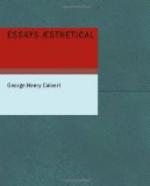In these passages the thought of the poet is thrust up through the overlaying crust of the common, by a warming, expanding, inward motion, which is sped by a vitality so urgent and irresistible that, to make passage for the new thought, lightly is lifted a load which, but for this spiritual efficacy, could not be stirred, just as heavy stones are raised by delicate growing plants. To exert this power the poet is always moved at the instance of feeling. Poetry having its birth in feeling, no man can enjoy or value it but through feeling. But what moves him to embody and shape his feeling is that ravishing sentiment which will have the best there is in the feeling, the sentiment which seeks satisfaction through contemplation or entertainment of the most divine and most perfect, and ever rises to the top of the refined joy which such contemplation educes.
The poetic imagination is the Ariel of the poet,—his spiritual messenger and Mercury. A clear look into the above passages would show that the source of their power is in the farther scope or exquisite range the imagination opens to us, often by a word. For further illustration I will take a few other examples, scrutinizing them more minutely. Had Lorenzo opened the famous passage in “The Merchant of Venice” thus,—
“How calm the moonlight lies upon this bank,”
and continued to the end of the dozen lines in the same key, saying,—
“There’s not the tiniest
star that can be seen
But in its revolution it doth hum,
Aye chanting to the heavenly
cherubins,”
his words would not have become celebrated and quotable. But Lorenzo has the privilege of being one of the mouth-pieces of Shakespeare, and so he begins,—
“How sweet the moonlight sleeps upon this bank.”
Two words, sweet and sleep, put in the place of calm and lies, lift the line out of prose into poetry. A log lies on a bank; so does a dead dog, and the more dead a thing is the more it lies; but only what is alive sleeps, and thus the word, besides an image of extreme stillness, brings with it what strengthens the image, the idea of change from liveliness to quiet; for that which was awake now sleeps; and the more full the picture of stillness, the more awake is the mind of the reader, awakened by the fitness and felicity of the image. The substitution of sweet for calm is, in a less degree, similarly enlivening; for, used in such conjunction, sweet is more individual and subtle, and imports more life, and thus helps the distinctness and vividness of the picture. How does the poetic Lorenzo word the other three lines?
“There’s not the smallest
orb which thou behold’st,
But in his motion like an angel sings,
Still quiring to the young-eyed
cherubins.”




